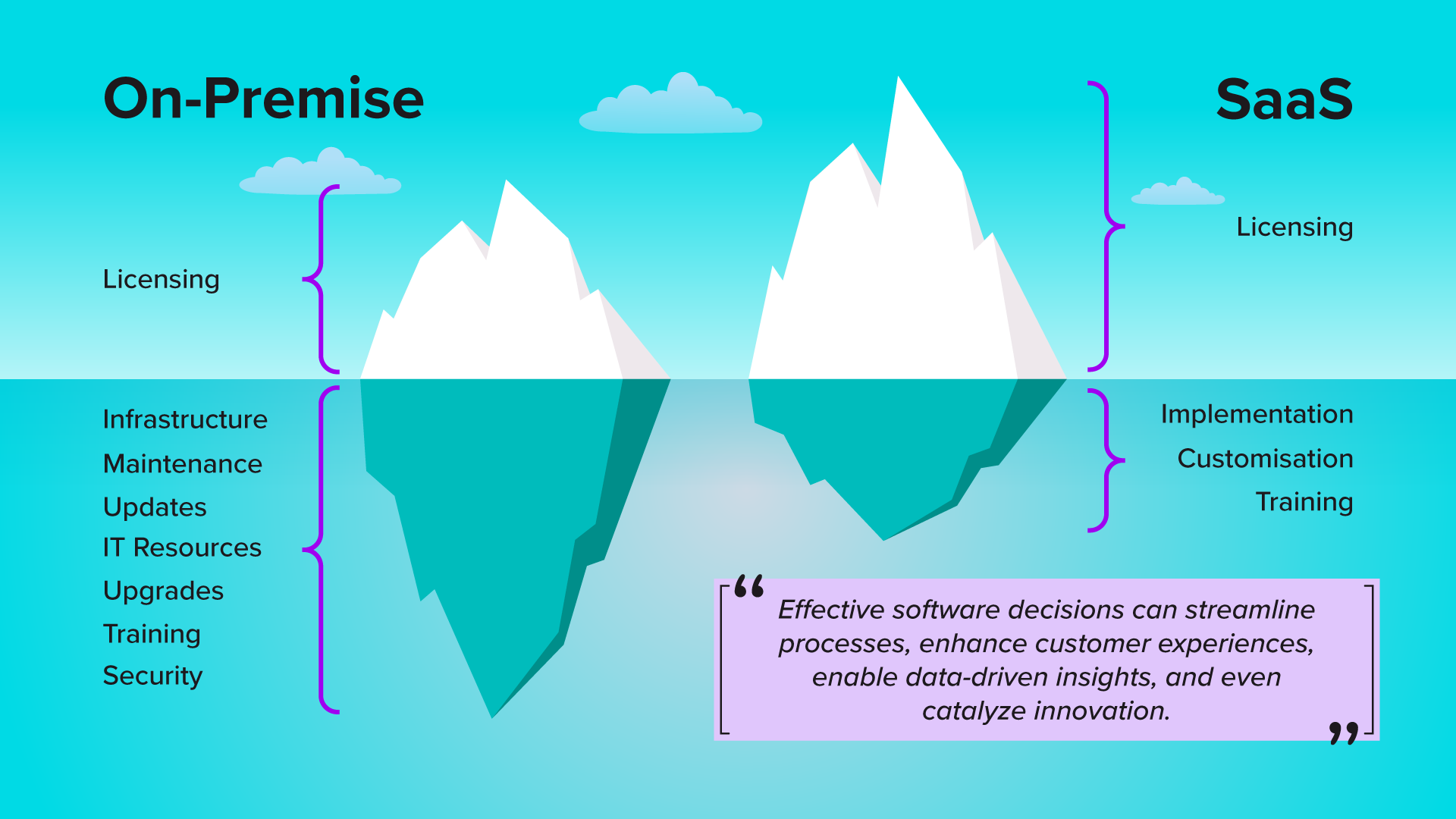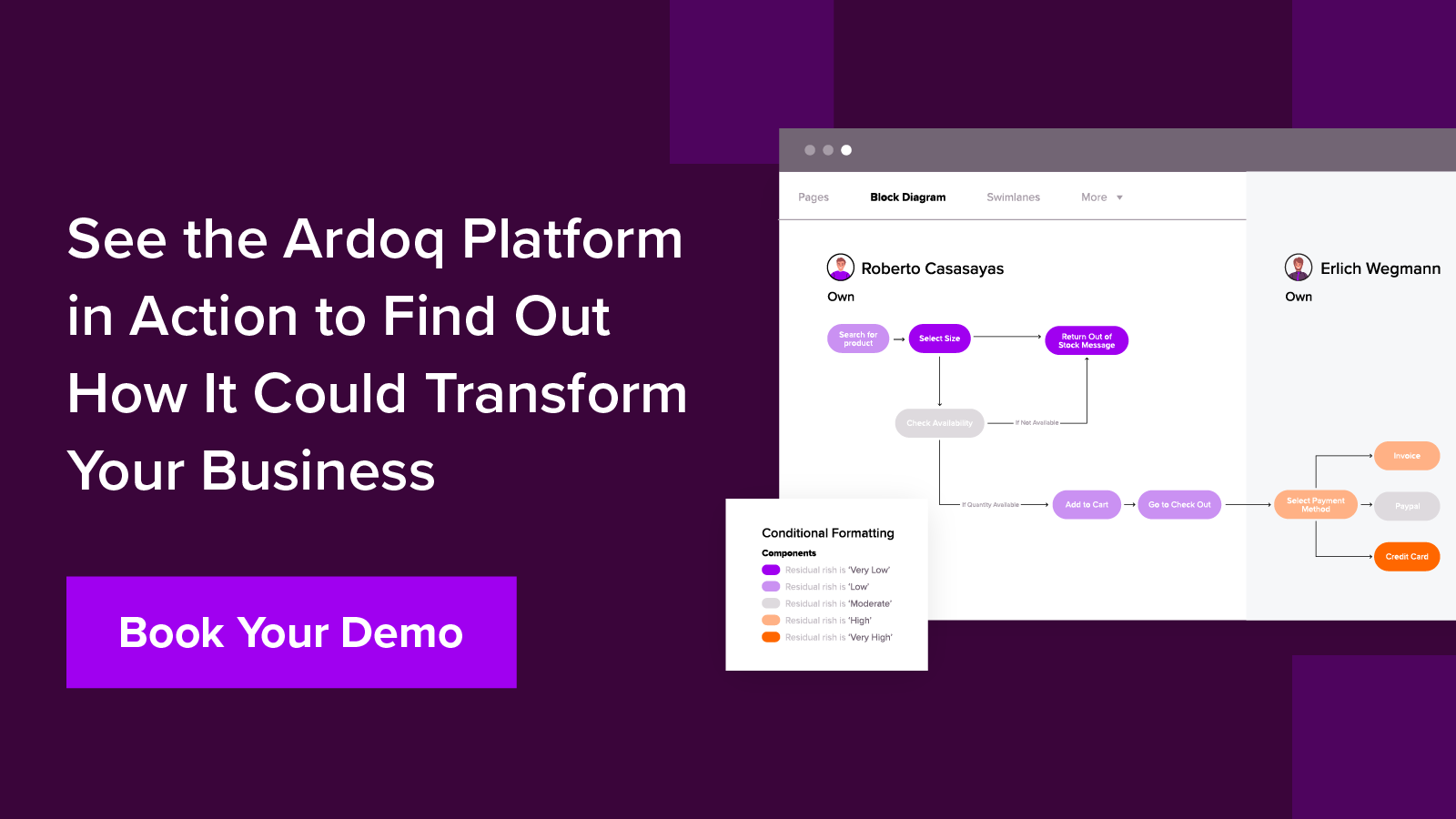This article was written by an external guest writer.
Software infiltrates every aspect of a business, and the choice of software model can profoundly impact a company's operations, customer interactions, and competitiveness. SaaS (Software as a Service) and On-Premise are two prominent models in the realm of software deployment that represent different approaches to how software is delivered, accessed, and maintained within a business environment.
SaaS is a cloud-based software delivery model where applications are hosted by a third-party provider and accessed by users over the Internet. On-premise software, in contrast, involves installing and running software on the organization's own infrastructure and servers.
Effective software decisions can streamline processes, enhance customer experiences, enable data-driven insights, and even catalyze innovation. On the other hand, an ill-suited software choice can lead to inefficiencies, hampered productivity, and even data breaches, jeopardizing sensitive information.
By weighing the trade-offs between SaaS and On-Premise models, organizations can embark on their software journey with a holistic understanding, leading to sound decisions that propel their success in a digitally-driven world.
What is SaaS?
In the dynamic landscape of software delivery, Software as a Service (SaaS) has emerged as a transformative paradigm that revolutionizes how businesses access and utilize software applications.
Unlike traditional software installation, where programs are purchased, downloaded, and installed on individual devices, SaaS delivers software applications on a subscription basis. Instead of purchasing licenses or physical copies of the software, users subscribe to SaaS solutions which are accessed through a web browser.
SaaS Benefits
Emerging as a prompt response to fast-evolving business needs and requirements in the era of global digitization, SaaS has gained immense popularity. The range of benefits it offers makes it an attractive choice for industries and businesses of all sizes.
- Accessibility: The ability to access applications from anywhere simply with the Internet, whether in the office, at home, or on the go, fosters a flexible and mobile work environment. This promotes productivity and collaboration. It’s a great solution for remote and distributed teams, enabling users to work from different locations and devices.
- Scalability: SaaS solutions can seamlessly adjust to accommodate changing business demands and user needs. Such agility ensures that resources are aligned with operational needs. Businesses can easily scale up or down based on user requirements, adding or removing licenses as needed. This agility ensures that resources are aligned with operational needs.
- Automatic Updates: Service providers handle software maintenance, including updates, patches, and security enhancements. This relieves businesses from the burden of managing software updates and ensures that users always have access to the latest features and improvements.
- Cost Savings: This model eliminates the need for upfront investments in hardware, software licenses, and maintenance. The subscription concept also allows businesses to predict and manage their software costs more effectively.
- Focus on Core Activities: By outsourcing software management and maintenance to SaaS providers, organizations can focus more on their core activities and strategic initiatives rather than dedicating resources to IT routines.
Common Use Cases for SaaS Solutions
SaaS finds applications across a wide range of industries and business functions:
- Enterprise Architecture: Cloud-based Enterprise Architecture platforms like Ardoq are designed to be quick and responsive in modern cloud environments where businesses use a suite of SaaS apps for their operational activities.
- Collaboration Tools: SaaS platforms like Google Workspace, Microsoft 365, and Slack facilitate real-time collaboration, document sharing, and communication among teams, irrespective of their physical locations.
- Customer Relationship Management (CRM): SaaS-based CRM solutions like Salesforce offer businesses a centralized platform to manage customer interactions, sales pipeline, and marketing campaigns.
- Human Resources Management: Specialized HR software streamlines recruitment, employee onboarding, performance management, and payroll processes.
- Enterprise Resource Planning (ERP): SaaS ERP systems enable efficient management of business processes, including finance, inventory, and supply chain, in a unified platform. This integration is crucial for the success of OSS/BSS transformation in modern telecommunications.
- Project Management: Tools like Asana and ClickUp assist teams in planning, tracking, and managing projects collaboratively.
SaaS redefines how organizations engage with software, offering flexibility and cost savings, and allowing companies to catch up with emerging opportunities and tech innovations.
What Are On-Premise Solutions?
As the name suggests, an on-premise solution entails deploying software applications or systems directly on the local infrastructure of an organization. Instead of relying on external cloud servers, all the hardware, software, and data management is handled within the organization's premises. The organization takes full responsibility for all related infrastructure.
Advantages of On-Premise Solutions
These solutions offer a set of advantages that can make them a good addition to SaaS for specific situations:
- Control: Companies have full control over the software, its updates, and its maintenance. This can benefit businesses with strict compliance requirements or specialized security needs.
- Customization: Organizations have greater freedom to customize and tailor the software to their specific needs. This level of customization is often more challenging in standardized cloud-based solutions due to shared resources.
- Data Security: Businesses that deal with sensitive or confidential data may prefer on-premise solutions, as they keep data within the company's boundaries, reducing the risk of external breaches and unauthorized access.
- Compliance: Businesses operating in regulated industries with strict data protection regulations may opt for on-premise solutions to maintain compliance more effectively.
- Offline Access: On-premise software doesn't rely on an Internet connection, allowing users to access and use applications even in environments with limited or unreliable connectivity.
Common Use Cases for On-Premise Solutions
On-premise solutions are usually applied in scenarios that benefit from this software implementation model. Some of these scenarios are:
- Highly Secure Environments: Industries that deal with sensitive data and strict regulatory compliance often opt for internal solutions to maintain maximum control and security.
- Customized Workflows: Organizations with unique or complex business processes that require tailored software functionalities often prefer in-house frameworks for their customization capabilities.
- Legacy Systems: In cases where an organization heavily relies on legacy systems or has existing internal infrastructure, adopting cloud solutions might be more complex. Thus, they continue using on-premise systems.
- Limited Internet Access: Locations with limited or unreliable Internet connectivity may find custom solutions more reliable for maintaining continuous operations.
On-Premise vs SaaS: Detailed Comparison
To choose the best software deployment option for business needs, it is useful to clarify the difference between SaaS and On-Premise by comparing the two models across different dimensions.
Cost Considerations
SaaS solutions are typically built around subscription-based pricing models. Businesses pay regular subscription fees instead of upfront costs associated with hardware, licenses, and infrastructure setup. This approach allows for spreading out costs over time, making it easier to manage budgets. However, the cumulative subscription fees might exceed the upfront expenses of an on-premise solution over the long term.
On-premise solutions, however, require significant upfront investments in the local system design and setup. While this can be a considerable expense initially, organizations may benefit from lower ongoing costs once the infrastructure is in place.
Maintenance and Updates
With SaaS, maintenance and updates are the responsibility of the provider. This eliminates the need for businesses to allocate resources to software maintenance and upgrading. Users automatically receive the latest features and fixes, ensuring a consistent experience across the user base.
Conversely, on-prem frameworks require organizations to manage maintenance, updates, and security measures internally. This calls for dedicated IT resources to ensure the software remains up-to-date and secure.
Scalability Potential
SaaS solutions offer elastic scalability. Businesses can easily scale up or down based on user demand. The cloud-based infrastructure allows resources to be allocated dynamically, ensuring optimal performance even during spikes in usage.
Meanwhile, scaling on-prem systems is a more complex and tricky task. Adding users or expanding infrastructure often involves purchasing additional hardware and engaging extra resources, which leads to higher upfront costs and potential overprovisioning.
Security Aspects
SaaS providers invest heavily in security measures to protect user data. While some organizations might have concerns about data residing off-site, reputable service providers implement robust encryption, authentication, and access controls to ensure top-of-the-line data protection.
In-house models offer more direct control over data security, appealing to industries with stringent compliance requirements. However, maintaining a high level of security demands internal expertise and resources.
Customization and Integration Capabilities
SaaS applications are often designed with standardized features to cater to a wide user base. While some level of customization is possible, it may be limited compared to on-premise solutions. Integrating SaaS with existing systems might require API-based connections.
In the meantime, internal solutions initially allow for extensive customization and integration. Organizations can tailor the software to fit their specific needs and seamlessly integrate with legacy systems.
Accessibility and Remote Work Implications
Cloud-based solutions excel in accessibility. This enables efficient remote work and collaboration. Users with an Internet connection can access applications from anywhere, fostering flexibility and real-time collaboration among dispersed teams.
In-house frameworks might require VPNs or remote desktop solutions to enable remote access. This could introduce latency and limit the seamless nature of remote work.
Use Cases and Suitability of SaaS or On-Premise Models
The choice between Software as a Service and In-House deployment models hinges on the specific needs and priorities of each organization. Likewise, it heavily depends on the characteristics of different industries. So, let’s take a look at the industries that are well-suited for each model.
Benefits of SaaS
Enterprises that want to focus on cost- and resource-effectiveness and prioritize agility and adaptability can benefit greatly from SaaS. It helps organizations move and grow fast. The following are examples of situations that benefit from SaaS tools:
- Enterprises: Cloud-based applications enable large companies to move like small ones with rapid deployment, helping projects to hit the ground running and can be easily scaled depending on the company's needs.
- Small and Medium-Sized Businesses (SMBs): SMBs often lack the IT resources and expertise to manage complex software infrastructure. SaaS provides an affordable and efficient way for these businesses to access essential tools without worrying about maintenance and updates.
- Collaboration-Driven Industries: The model is ideal for marketing agencies, design studios, and remote teams. Real-time access to shared documents, communication platforms, and project management tools streamlines workflows.
- E-commerce and Retail: SaaS e-commerce platforms are a quick and cost-effective way for businesses to establish and manage online stores. They provide features like inventory management, payment processing, and customer relationship management without the need for extensive technical expertise.
Benefits of SaaS On-Premise Combination Solutions
These areas primarily call for custom-tailored concepts, require the ultimate data security, and are ready to invest in internal systems setup and maintenance. SaaS solutions like Enterprise Architecture are great for lessening the burden of on-premise reliance. For example:
- Highly Regulated Sectors: Healthcare, finance, and government often have strict compliance requirements and data privacy regulations. SaaS software can work well in regulation-bound industries by enhancing security and expanding the management functionality of their software solutions.
- Manufacturing and Industrial Sectors: Recent SaaS solutions have developed integration capabilities allowing for combining on-premise and SaaS models or ensuring a smooth transition to SaaS, no matter the initial system complexity.
- Data-Centric Sectors: Companies dealing with large volumes of proprietary or sensitive info, such as research and development, may prefer to keep data partially or entirely within their infrastructure for intellectual property protection.
Making the Right Choice
When comparing the benefits of SaaS vs. On-Premise, it’s crucial to make a decision that perfectly aligns with your organization’s needs and objectives. To make an informed choice, start by assessing those needs:
- List your organization's software requirements, including functionality, scalability, security, and integration needs. Prioritize them based on their importance to your business.
- Determine the number of users who will require access to the software. Consider whether your user base is expected to grow significantly over time.
- Estimate your budget for both upfront costs and ongoing expenses. Consider how each pricing model aligns with your financial resources. Evaluate the total cost of ownership.
- Assess the sensitivity of your data and the regulatory compliance requirements of your industry to determine whether data security and control are paramount concerns.
- Analyze the degree of customization required and consider your organization's growth projections to outline customization and scalability demands.
Benefits of SaaS as the Most Suitable Deployment Model
Once you outline your business needs, take your time to explore a few other benefits of SaaS models to ensure you select the right deployment model. Think about how SaaS can be incorporated into factors such as:
- Industry and specific compliance requirements. SaaS models can increase the degree of control.
- Technical expertise to evaluate your organization’s proficiency since internal solutions, for example, require in-house IT expertise.
- Deployment speed to choose between faster and simpler SaaS applications and more complex and lengthier internal system setups.
- Long-term strategy to make sure the organization is agile enough to accommodate future growth and technological changes.
- User experience and ease of adoption. Custom internal frameworks that benefit from SaaS solutions usually boast intuitive interfaces.
Understand Your Organization's Needs
Naturally, your software deployment choice should accurately align with your overall business strategy, objectives, and growth trajectory to give your company a competitive advantage by streamlining operations, enhancing customer experiences, and improving collaboration.
Whether you opt for the flexibility and accessibility of SaaS or combine it with the control and customization of On-premise solutions, making informed software decisions requires a deep understanding of your organization's needs, industry context, and long-term goals. By carefully evaluating control, cost, security, scalability, and alignment with business objectives, businesses can confidently select the combination deployment model that optimally empowers their organizations’ success.
Ardoq's cloud-based approach Enterprise Architecture allows us to innovate faster based on customer needs and deliver a better experience than legacy platforms that bring together separate components that are both on-premise and in the cloud. Ready to see the difference cloud-native EA makes? Book a demo below.
 Roy Emmerson
Roy Emmerson is a passionate technology enthusiast with a deep interest in software development. In addition to being a skilled programmer at a custom software company, he is also a loving father of twins who inspire him to stay up-to-date with the latest technological advancements.
Roy Emmerson
Roy Emmerson is a passionate technology enthusiast with a deep interest in software development. In addition to being a skilled programmer at a custom software company, he is also a loving father of twins who inspire him to stay up-to-date with the latest technological advancements.








